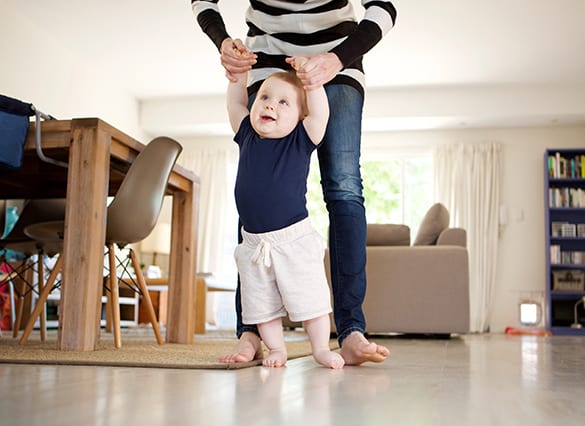
All babies are born with flat feet
Podiatrists often see children brought in by parents anxious about ‘flat feet’ (also called ‘pes planus’).
Parents are often surprised to learn, however, that all babies are born with flat feet, and that flat feet are normal in infants and young toddlers – due to weak muscle tone in the foot, a considerable amount of baby fat across the arch and loose ankle ligaments that allow the feet to roll inwards.
As your child masters walking, the ligaments and muscles will strengthen and the baby fat will reduce, making the arch more noticeable. By around four years of age, your child should have developed a normal arch in both feet.
If your child’s flat feet persist after the age of four, it is important to have their foot posture and development checked by your podiatrist.
A young child’s foot is made predominantly of cartilage, which is much softer than bone. This makes the child’s foot much more susceptible to the abnormal weight-bearing forces that are produced by having flat feet or collapsed arches. These abnormal forces can lead to permanent structural damage to the bones and joints of the feet that can continue into adulthood.
What causes flat feet in children?
There are various causes of flat feet in children including:
- Joint hypermobility – where the joints have a greater range of movement than normal allowing the arches to collapse under the child’s body weight
- Hypotonia – low muscle tone
- Tight calf muscles or Achilles tendon
- Family inheritance of foot type
- Tarsal Coalition – where there is an abnormal connection between two bones in the foot that are not normally connected, resulting in a stiff flat foot
- Down Syndrome – flat feet are common in children with Down Syndrome due to the combination of low muscle tone and joint hypermobility
- Cerebral Palsy – due to muscle imbalance and spasticity
- Congenital Vertical Talus – a congenital foot deformity causing a rigid rocker bottom foot
- Complex genetic disorders of connective tissue, such as Marfans Syndrome or Ehlers Danlos Syndrome
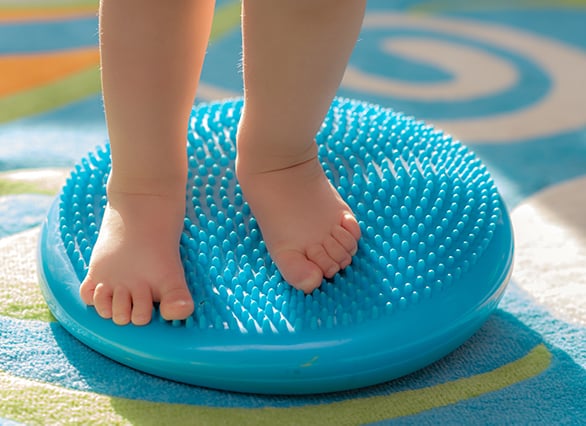
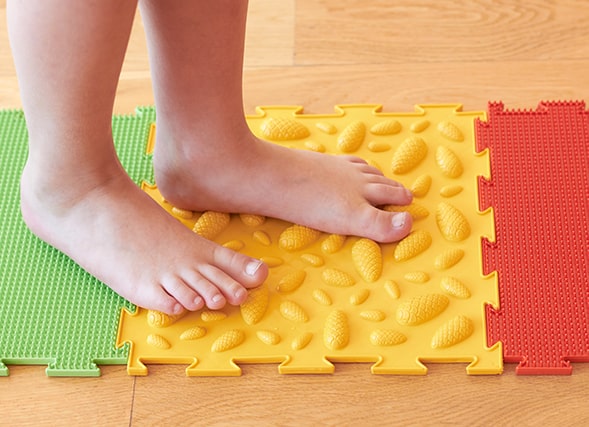
How can flat feet affect my child’s development?
Paediatric flat feet may have several potential complications for your child’s development, including:
- reluctance to participate in school sports, because of physical discomfort or an awkward gait
- a possible increased risk of developing early osteoarthritis in the future
- an increased risk of developing juvenile bunions
What are the symptoms of flat feet?
The most common symptoms related to flat feet in children include:
- Pain around the arch, heel or ankle when standing, walking or running
- ‘growing pains’, or night time leg pain that disturbs sleep
- Joint pains, especially after physical activity or sport (eg; knee pain, shin splints, ankle or heel pain)
- Tired or easily fatigued legs, generalize aches and pains in the legs and feet
- Difficulties keeping up with their peers in school sports or sport refusal, with your child not wanting to participate in running or jumping sports
- Awkward or an unbalanced gait
- Growth plate inflammation including Severs disease and Osgood Schlatter disease
- Poor balance and coordination, or ‘clumsiness’, due to impaired joint proprioception
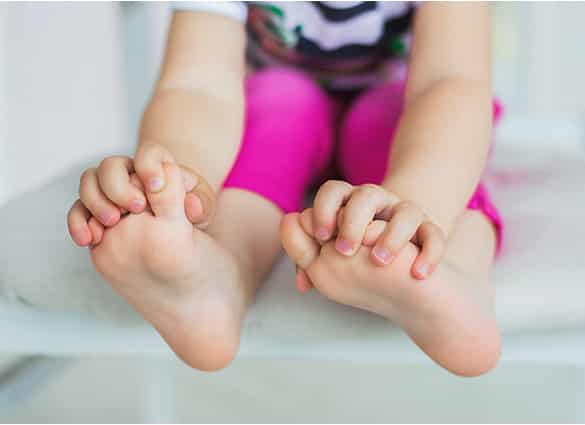
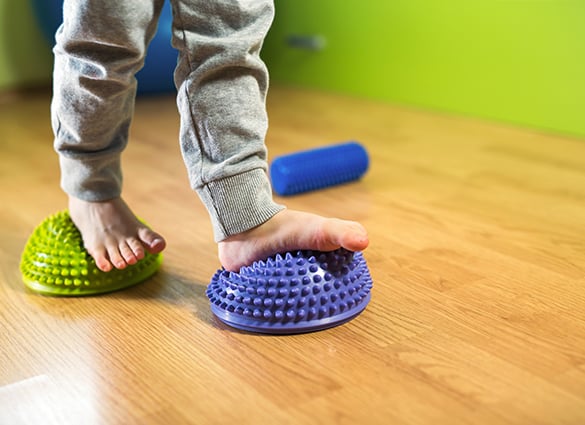
How are flat feet diagnosed?
Your podiatrist will take a comprehensive medical history and perform a physical examination including a gait analysis. The assessment will include:
- foot posture assessment
- joint flexibility (or range of motion)
- biomechanical assessment of the foot, ankle and leg
- foot and leg muscle strength testing – looking for muscle imbalances and weakness
- Beighton hypermobility score – to screen for joint hypermobility
- footwear assessment – looking for abnormal shoe wear patterns
- Gait analysis – to look for any abnormalities in the way the feet move during gait
- A plain x-ray may also be ordered to look more closely at the alignment of the joints of the feet and to check for a tarsal coalition
How are flat feet treated?
If your child does not have painful symptoms, and their foot posture and arch development are within a normal range for their age, treatment may not be required. Your Podiatrist may simply offer advice on the best types of footwear for your child.
However, if your child has developed flat feet or collapsed arches, it is important their abnormal foot posture is treated early, using foot orthotics inside supportive, stable shoes. Orthotics can effectively reduce foot, ankle, knee and leg pain related to flat feet. Their additional corrective support will encourage normal development while preventing further deformity and reducing abnormal forces on the feet, ankle, knees, hips, pelvis and spine during the formative years. Depending on your child’s age, foot posture and symptoms, your podiatrist will recommend either prescription orthotics or non-prescription orthotics.
In addition to prescribing orthotics and recommending supportive school and sports footwear, your podiatrist will advise your child on specific exercises to strengthen their foot and ankle muscles and improve their balance and joint proprioception.
In some severe cases where the flat foot is stiff and painful and associated with a tarsal coalition, a referral to a foot and ankle surgeon is required.
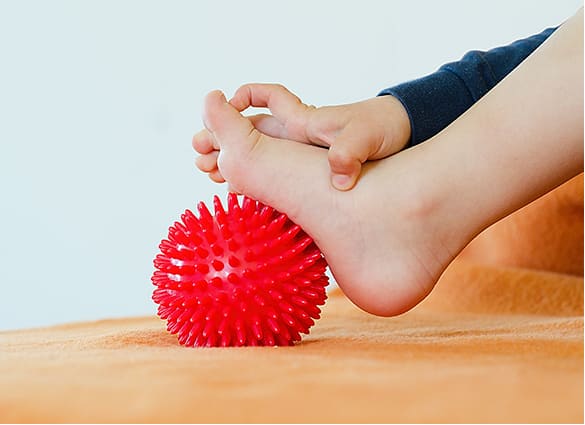
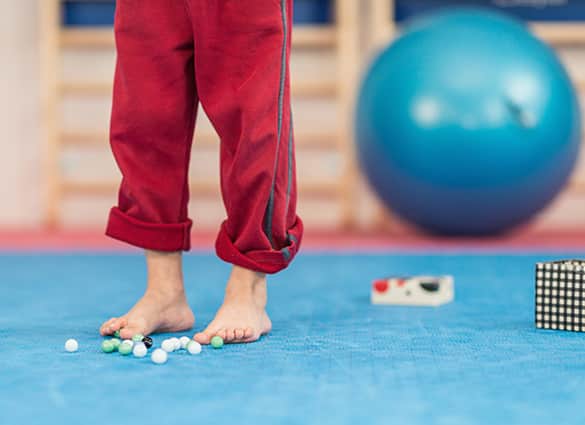
What should I do if my child has flat feet?
For some children, flat feet cause no symptoms or long term problems at all. However, many children with flat feet will go on to experience foot, knee or leg pain, develop juvenile bunions or will not be keen to participate in sports. This is never normal and should always be followed up by your podiatrist.
You should see a podiatrist if:
- Your child complains of pain in the feet, ankle, knees or legs or develops a limp
- Your child has not developed an arch by 4 years old
- Your child has only one foot that is flat
- You notice abnormal wear patterns on your child’s shoes
- Your child is not keen to participate in sport or exercise
- If there is a family history of bunions
- You have any concerns regarding your child’s foot posture or development.
Our podiatrists in Brisbane Northside include specialists in children’s foot conditions. If you think your child has flat feet, or you are at all concerned about the posture of their feet, contact us.

